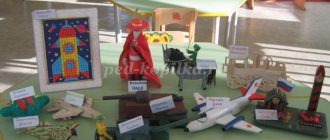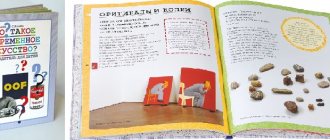Memo for parents “How to introduce children to professions”
Introducing preschoolers to the world of professions is an important stage in the process of professional self-determination of the individual. It is at this time that children are actively socialized and ideas about the world of professions accumulate. The world of professions in society is a complex, dynamic, constantly evolving system.
Every day, a child is surrounded by a dozen people who perform their professional duties - doctors, salesmen, drivers, educators, waiters, and by getting acquainted with one or another professional activity, the child discovers a lot of new things, expands his horizons, and enters society. You can often hear from a child: “When I grow up, I’ll be a doctor!” or “I want to be a driver, like dad!” Seeing your son or daughter's interest in any professional field, use this moment to unobtrusively introduce the child to its features.
According to experts, a person’s choice in favor of one specialty or another most often occurs precisely in preschool age. Therefore, it is so important to convey information about professions to the child in an interesting, multifaceted way and without showing a negative attitude.
All parents, without exception, want their children to be happy, to have success in life, to be fulfilled in some activity. That is, they got a profession to their liking, focusing on their aspirations and desires. Parents need to notice what their child gravitates towards most.
Getting acquainted with professions should begin as early as possible. A caring attitude towards work and the ability to work in a team are qualities that need to be cultivated in children. Familiarity with the work of an adult is of great importance in their upbringing.
Here are some effective tips for introducing children to different types of professional activities.
Watch adults work while walking. While walking with your baby, or going to kindergarten, to the doctor, to the store, or on other routes, pay attention to those who are working at that time - a janitor, a salesman, a driver, a builder, a teacher, a doctor, etc. Talk to your child about this , what exactly each of the specialists does, and that their work must be treated with respect.
For example, teach your child to throw garbage only in the trash can. Tell him that street cleaners sweep the streets early in the morning so that the city is clean and everyone enjoys walking in it. In the store, pay attention to the fact that the goods were delivered in large trucks early in the morning, then loaders unloaded them, and the sellers carefully arranged everything on the shelves.
Tell your child about your work - what you do, what you do especially well, what you would like to achieve. Try to explain the essence of your work, its importance for other people. For example, dad, together with other builders, builds houses so that people can live there, or dad works as a fireman. Let him tell his son or daughter about how he receives a message about a call to put out a fire, what he is responsible for on the team, how he and his colleagues act when they reach their destination, what difficult cases there are. Highlight the professions of the people who work with you. Speak respectfully about your colleagues. Tell them that you like to benefit people and that you enjoy going to work. Show off the certificates and awards you have received. You should not instill in your child your opinion about the attractiveness of one profession over another. This creates a disdainful attitude towards people in these professions. After all, someone, for example, needs to wash the floor and carry garbage.
After talking with your child about existing professions, offer to draw one of the specialists, for example, a doctor. While drawing, make up a story about the doctor’s work, you can read poems about professions, and once again talk about how important they all are.
Children also become acquainted with professions during games. Be sure to play with your child about different professions. Give him the opportunity to be a cook, a doctor, a policeman, a teacher, etc. This is the best opportunity for a child to get to know the profession from the inside, learn interesting nuances, and try to make responsible decisions. You will see your child literally grow up before your eyes.
Draw various objects, shapes, symbols related to a particular profession, ask the child to guess who exactly they belong to. You can continue the game by making riddles on the topic of “profession”. Children enjoy participating in such tasks. Play with your child board and printed games related to professions. For older children, cards, lotto games, doctor games, and store games are suitable. In addition to all this, draw or paint together representatives of different professions, their tools, and clothes. Discuss who is doing what, listen to the child’s opinion about whether he wants to do it or not.
Children can learn about professions by reading books.
Many children's poets and writers set out descriptions of certain working professions in their works: J. Rodari - “What do crafts smell like?” V. Mayakovsky - “Who to be?” A. Barto - “The Painter”, “Song of Sailors”, “Veterinarian”. S. Mikhalkov - “Hairdresser”, “Uncle Styopa”. B. Zakhoder - “The Dressmaker”, “The Builders”, “The Shoemaker”, “The Driver”. S. Chertkov – For children about professions: “Border Guard”, “Milkmaid”, “Magician”, “Cook”, “Hairdresser”, “Carpenter”, “Veterinarian”, “Pilot”, “Sailor”, “Farmer”, “Fisherman” ”, “Firefighter”, “Scientist”, “Musician”, etc. By reading the work and showing the illustration, you can clearly explain to the child who the border guard, postman or mechanic is.
When studying different professions with your child, do not forget to consolidate the acquired knowledge by repeating information in an easy, entertaining way. And remember that one of the important tasks is not only to develop in the child an understanding of the importance of each profession, but also respect for the work of the people around him, who put a lot of effort and effort into their work and truly love their job.
Nazarova-estalsad59.edumsko. ru
Didactic games “Professions” in the senior group
Preschoolers in the older group should already know a wide range of professions, as well as have an idea of the professional responsibilities of different workers and the tools they use.
List professions starting with the selected letter
The teacher places cards with letters face down on the table. Children take turns coming to the table, taking a card, calling professions that begin with the chosen letter:
- A – actor, agronomist, astrologer, administrator, aviator, lawyer, architect, obstetrician;
- B – accountant, bookseller, bartender, banker, accordion player, librarian, ballerina, boxer;
- B – doctor, makeup artist, driver, diver, teacher, veterinarian;
- G – geologist, governess, loader, make-up artist;
- D – janitor, conductor, designer, nutritionist, truck driver, milkmaid, dispatcher, director;
- F – livestock breeder, journalist, jockey;
- Z – sound engineer, zoologist, manager;
- I – inspector, engineer, inventor, art critic, illustrator, historian;
- K - astronaut, clown, captain, combine operator, composer, cashier, fireman, blacksmith;
- L – laboratory assistant, pilot, lumberjack, speech therapist;
- M – driver, fashion model, painter, nurse, meteorologist, mechanic, installer, musician;
- N – nanny, notary, oil worker;
- O – ophthalmologist, waiter, operator, landscaper, security guard;
- P – shepherd, cook, pediatrician, writer, hairdresser, pianist, carpenter, postman, salesman;
- R – director, radio operator, fisherman, reporter;
- S – secretary, plumber, gardener, violinist, mechanic, sculptor, dentist;
- T – tractor driver, turner, chimney sweep, trainer;
- U – cleaner, teacher, scientist;
- F – photographer, florist, pharmacist, farmer, philosopher, football player;
- X – surgeon, artist, choreographer;
- Sh – miner, seamstress, driver, plasterer;
- E – ecologist, electrician, tour guide, economist, excavator operator;
- Yu is a lawyer, cabin boy, jeweler.
What is this builder called?
The game introduces preschoolers to construction professions. The teacher says what the person does, and the children answer what they call him:
- paints walls - painter;
- covers the roof with tiles - a roofer;
- builds a house from brick - mason;
- connects metal parts - a welder;
- lays tiles on the walls - a tiler;
- makes the walls smooth, applies plaster - plasterer;
- makes parts from wood - carpenter.
Name your profession based on the result of your work
The teacher shows the pupils cards depicting the result of the work, and they must guess who is doing the work. For example, the picture “suit” is the profession “seamstress”. Or “cake” – “confectioner”. Or “house” – “builder”.
Name the extra item
The teacher places in front of the children 4 illustrations of tools used by certain workers. One of the items is superfluous, it must be pointed out with an explanation of the reason for the choice. For example, “trowel”, “helmet”, “drill”, “syringe” - the first three are used by a builder, the last item is used by a nurse.
Ambulance
The game forms in preschoolers an idea of the importance of the medical profession. For the lesson, you need to prepare pictures depicting the tools and consumables that emergency personnel use: a syringe, bandage, iodine, thermometer, bandage, etc.
During the game, different situations are considered. One child plays a doctor, the second plays a patient. The second one tells what problem he has: a broken knee, a scratched hand, bleeding from the nose, sore throat, headache, etc. The child playing the doctor tells what tools and medicines he will use in each specific case. If necessary, the teacher prompts him.
Pharmacy
A role-playing game introduces preschoolers to the profession of a pharmacist. For the lesson you need to prepare pictures depicting medicines and cards imitating “money”. Children distribute roles. One becomes a pharmacist at the cash register, the rest become customers. The roles alternately change.
Customers take turns “entering the pharmacy.” They say that they are worried about whether the medicine they need is available. The pharmacist offers the buyer a product and collects payment. The teacher helps the players, gives tips on prescribing medications, and asks leading questions.
Didactic games “Professions” in the middle group
The task of a teacher in the middle group is to expand and consolidate students’ knowledge about different professions, develop their thinking ability, concentration, ability to navigate, and give clear and competent answers.
What to whom?
To get acquainted with professions, the presenter names the worker, and the children must list the tools, devices and materials that he uses:
- doctor - syringe, stethoscope, medical gown, rubber gloves, bandage, medical card;
- builder - drill, hammer, bricks, boards, helmet, concrete, nails, saw;
- teacher - pointer, class magazine, textbooks, wall maps, blackboard;
- artist - paints, brushes, canvas, palette, easel, paper, pencils;
- cook - dishes, oven, blender, cap, apron, food, recipe book;
- hairdresser - hair dryer, combs, scissors, curling iron, hair dyes, hairpins, mirror;
- gardener - rake, gloves, shovel, seedlings, lawn mower, pruning shears, watering can;
- seamstress - sewing machine, iron, ironing board, scissors, fabric, needles, threads.
This is true?
For the game you need to prepare pictures depicting people of different professions in appropriate attire. Each player receives two cards: red – the answer is “no”, green – “yes”.
The presenter shows the children a picture and says who the person drawn works for. Players must understand whether what is said is true and raise the appropriate card. For example, the presenter, showing a picture of a fireman, says: “This is a teacher.” Children hold up a red card.
Work clothes
To play, you need to cut out paper images of a girl and a guy, as well as different work clothes.
The teacher says that the paper characters are going to go to work, but they need help choosing the right suit. The game can be built in different ways. The teacher names a profession, and the children choose the correct one from a heap of paper clothes. Or the teacher chooses the costume himself, and the players name the character’s place of work. When the children have sorted out their work wardrobe, the teacher asks them to close their eyes to consolidate the acquired knowledge, and he himself rearranges the clothes and asks them to find the mistake.
Work transport
To play, you need to arrange chairs and attach to each chair an image of a specific car: ambulance, fire, police, bus, plane, train and others. And cut out “steering wheels” from cardboard with professions written on them.
The presenter gives each player a steering wheel and names their profession. The player must find his “car”, sit on a chair, steer, “going to work”. The game is repeated, the presenter changes the players' steering wheels.
For a cook or a doctor?
This didactic game “Professions” for kindergarten systematizes ideas about the work responsibilities and professional characteristics of a cook and a doctor.
Two children are playing: one is a cook, the other is a doctor. The presenter pulls items out of the bag and asks which worker needs them. For example, a doctor needs a syringe, a cook needs a spoon. Children should not just answer, but explain why the employee needs this item.
Didactic games “Professions” in the younger group
Preschoolers of the younger group learn through games how important all professions are and what different workers do.
Salon
Pupils do the dolls' hairstyles and take care of their hair using various devices and products. The teacher observes the work of the pupils, coordinates them, and suggests rules for caring for their appearance. It is important to draw children’s attention to how ugly dolls look while they are unkempt and unkempt, which means that the profession of a hairdresser is necessary. You should also tell children about the tools used in the hairdressing salon and their purpose.
Guess the profession based on the subject
The teacher pulls an item out of the bag, and the children say who might need it. For example, a cook needs a ladle, a nurse needs a bandage, a painter needs a brush, and a hair dryer needs a hair dryer.
Guess who am I?
Children stand in a circle. Each player, in turn, goes to the center and begins to depict a certain action, without saying a word, using only facial expressions, body movements, and inarticulate sounds. The rest must guess who the comrade is portraying. For example, a child makes twisting movements with his hands, imitating a steering wheel, and says “w-w-w.” This is the driver.
Correct mistakes
The presenter names paired phrases, and the children say what the mistake is and how to say it correctly:
- the teacher mows the lawn and the gardener writes on the blackboard;
- a barber puts out a fire, and a fireman does a haircut;
- a musician paints the walls and a painter plays the piano;
- the nurse prepares a pie, and the cook gives an injection to the patient;
- the builder offers books to readers, and the librarian builds brick walls.




